A presentation at Workshop Notes in June 2017 in 91074 Herzogenaurach, Germany by Bilal Çınarlı


Bilal Çınarlı Frontend Architect Software Engineer @Adidas
@bcinarli github.com/bcinarli
bcinarli.com


• What is HTML5 and Applications? • JavaScript Design Patterns • You Might Not Need JavaScript • Rest APIs and its advantages • JavaScript Packages and Dependency Management Content • Gulp, WebPack task managers and module bundlers • Modern JavaScript Coding & ES6 • ReactJS


What is HTML5?



• Giving meaning to structure, semantics are front and center with HTML5.
• A richer set of tags, along with RDFa, microdata, and microformats, are enabling a more useful, data driven web for both programs and your users.


• CSS3 delivers a wide range of stylization and effects, enhancing the web app without sacrificing your semantic structure or performance.
• Additionally Web Open Font Format (WOFF) provides typographic flexibility and control far beyond anything the web has offered before.


• Audio and video are first class citizens in the HTML5 web, living in harmony with your apps and sites .


• Between SVG, Canvas, WebGL, and CSS3 3D features, you're sure to amaze your users with stunning visuals natively rendered in the browser.


• Web Apps can start faster and work even if there is no internet connection.
• The HTML5 App Cache, as well as the Local Storage, Indexed DB, and the File API specifications support storing Web Apps data in client .


• Beginning with the Geolocation API, Web Applications can present rich, device-aware features and experiences.
• Incredible device access innovations are being developed and implemented, from audio/video input access to microphones and cameras, to local data such as contacts & events, and even tilt orientation.


• More efficient connectivity means more real-time chats, faster games, and better communication.
• Web Sockets and Server-Sent Events are pushing data between client and server more efficiently than ever before.


• Make your Web Apps and dynamic web content faster with a variety of techniques and technologies such as Web Workers and XMLHttpRequest 2.

JavaScript Design Patterns


• a design pattern is a general repeatable solution to a commonly occurring problem in software design
• a design pattern isn't a finished design that can be transformed directly into code.
• a design pattern is a description or template for how to solve a problem that can be used in many different situations.

Module Design Pattern

( function () {
'contents' ;
function () {
contents ; }
return { callChangeHTML: function () {
changeHTML()
;
console.
log
(
contents
);
}
};
})();
HTMLChanger.
callChangeHTML
();
// Outputs: 'contents'
console.
log
(HTMLChanger.contents);
// undefined

Revealing Module Design Pattern

( function () {
10 ;
function () { console. log ( 'Inside a private method!' ); privateVariable ++ ; }
function () { console. log ( 'This is a method I want to expose!' ); }
function () {
privateMethod (); }
return { first: methodToExpose , second: otherMethodIWantToExpose
};
})();
Exposer.
first
();
// Output: This is a method I want to expose!
Exposer.
second
();
// Output: Inside a private method!
Exposer. methodToExpose (); // undefined

Prototype Design Pattern

function () {
4 ;
'Tesla' ;
function () {
// Rotate wheels
function () {
// Apply brake pads
}

Observer Design Pattern

function () {
[];
return { subscribeObserver: function (observer) {
this .observers. push (observer); },
unsubscribeObserver:
function (observer) {
this .observers. indexOf (observer);
if (index
1 ) {
this .observers. splice (index, 1 ); } },
notifyObserver:
function (observer) {
this .observers. indexOf (observer);
if (index
1 ) {
this .observers[index]. notify (index); } },
notifyAllObservers:
function () {
0 ; i < this .observers.length; i ++ ){
this .observers[i]. notify (i); }; } }; };

function () {
return { notify: function (index) { console. log ( "Observer "
index +
new
new
new
new
new
Observer (); subject. subscribeObserver (observer1); subject. subscribeObserver (observer2); subject. subscribeObserver (observer3); subject. subscribeObserver (observer4); subject. notifyObserver (observer2); // Observer 2 is notified!
subject. notifyAllObservers (); // Observer 1 is notified! // Observer 2 is notified! // Observer 3 is notified! // Observer 4 is notified!

Singleton Design Pattern

var printer = ( function () {
var printerInstance;
function create () {
function
print () {
// underlying printer mechanics
}
function
turnOn () {
// warm up, check for paper
}
return {
print:
print , turnOn: turnOn
};
}
return { getInstance: function () {
if (!printerInstance) { printerInstance = create (); }
return printerInstance; } };
function Singleton () {
if (!printerInstance) { printerInstance = initialize (); } }; })();

You Might Not Need jQuery

Selecting Elements

// with jQuery var $element = $ ( '.my-class' ); // without jQuery var $element = document. querySelectorAll ( '.my-class' ) ;

Finding Elements

// with jQuery $ ( '.my-class' ). find ( child-element ); // without jQuery var $element = document. querySelector ( '.my-class' ) ; $element. querySelectorAll ( child-element )

Add/Remove Classes

document. querySelector ( '.my-class' ) ; $element.classList. add ( 'new-class' ); $element.classList. remove ( 'old-class' );

Get/Set Content

document. querySelector ( '.my-class' ) ; $element.innerHTML; $element.outerHTML;

string ;

Get/Set Text

document. querySelector ( '.my-class' ) ; $element.textContent;

document. querySelector ( '.my-class' ) ; $element.textContent = string ;

Event Bindings

document. querySelector ( '.my-class' ) ; $element. addEventListener ( eventName , eventHandler ); $element. removeEventListener ( eventName , eventHandler );

Rest API with JSON

• Primary architectural approach for distributed systems. • REST stands for Representational State Transfer.
• It relies on a stateless , client-server , cacheable communications.
• In most cases it is used with the HTTP protocol .
• RESTful applications use HTTP requests to POST (create), PUT
(create and/or update), GET (e.g., make queries), and DELETE data.

Features

• each HTTP contains all the necessary information to run it
• the client can run the same response for identical requests in the future.
• Objects in REST are always manipulated from the URI.
• Uniform interface

The advantages of REST for development

• Separation between the client and the server
• Visibility, reliability and scalability
• The REST API is always independent of the type of platform or languages

{ " data ": [{ " type ": " articles ", " id ": " 1 ", " attributes ": { " title ": " JSON API paints my bikeshed! ", " body ": " The shortest article. Ever. ", " created ": " 2015-05-22T14:56:29.000Z ", " updated ": " 2015-05-22T14:56:28.000Z " }, " relationships ": { " author ": { " data ": {" id ": " 42 ", " type ": " people "} } } }], " included ": [ { " type ": " people ", " id ": " 42 ", " attributes ": { " name ": " John ", " age ": 80 , " gender ": " male " } } ] }

Single Responsibility Principle


• Every module or class should have responsibility over a single part of the functionality provided by the software . • That responsibility should be entirely encapsulated by the class.
• All its services should be narrowly aligned with that responsibility.

Single Page Application Development

JavaScript Packages & Dependencies

NodeJs

• Node.js is a platform built on Chrome's JavaScript runtime for easily building fast and scalable network applications

Packaging

{ " name ": " demo ", " version ": " 1.0.0 ", " description ": " Demo package.json ", " main ": " index.js ", " dependencies ": { " lodash ": " latest " }, " devDependencies ": {}, " scripts ": { " test ": " echo "Error: no test specified" && exit 1 " }, " author ": " Bilal Cinarli ", " license ": " MIT " }

NPM

• Node Package Manager • Default package manager in NodeJs

Yarn

• Yarn package manager • Deterministic Install with lockfiles

ES5 & ES6 KeyPoints


Variables

• let statement declares a block scope local variable, optionally initializing it to a value
• const cannot change through re-assignment, and it can't be redeclared

function varTest() {
1;
if ( true ) {
2;
// same variable!
console.
log
(
x
);
// 2
}
console.
log
(
x
);
// 2
} function letTest() {
1;
if ( true ) {
2;
// different variable
console.
log
(
x
);
// 2
}
console.
log
(
x
);
// 1
}

1; i <= 5; i ++ ) {
document. createElement ( 'li' ); item. appendChild (document. createTextNode ( 'Item '
function ( ev ) { console. log ( 'Item '
i +
1; i <= 5; i ++ ) {
document. createElement ( 'li' ); item. appendChild (document. createTextNode ( 'Item '
function ( ev ) { console. log ( 'Item '
i +
' is clicked.' ); }; })( i ); list. appendChild ( item ); }

20; // will print 7 console. log ( 'my favorite number is: '
20;

Arrow Function

• An arrow function expression has a shorter syntax than a function expression.
• Does not bind its own this, arguments, super, or new.target.
• These function expressions are best suited for non-method functions, and they cannot be used as constructors.

() => { return
() =>
arguments ; arr (); // 42

() => {}; (() =>
a => a
(a, b) => a
b ? a : b; // More concise promise chains promise. then (a => { // ... }). then (b => { // ... }); // Parameterless arrow functions that are visually easier to parse setTimeout ( () => { console. log ( 'I happen sooner' );
setTimeout ( () => { // deeper code console. log ( 'I happen later' ); }, 1); }, 1);

Object.assign
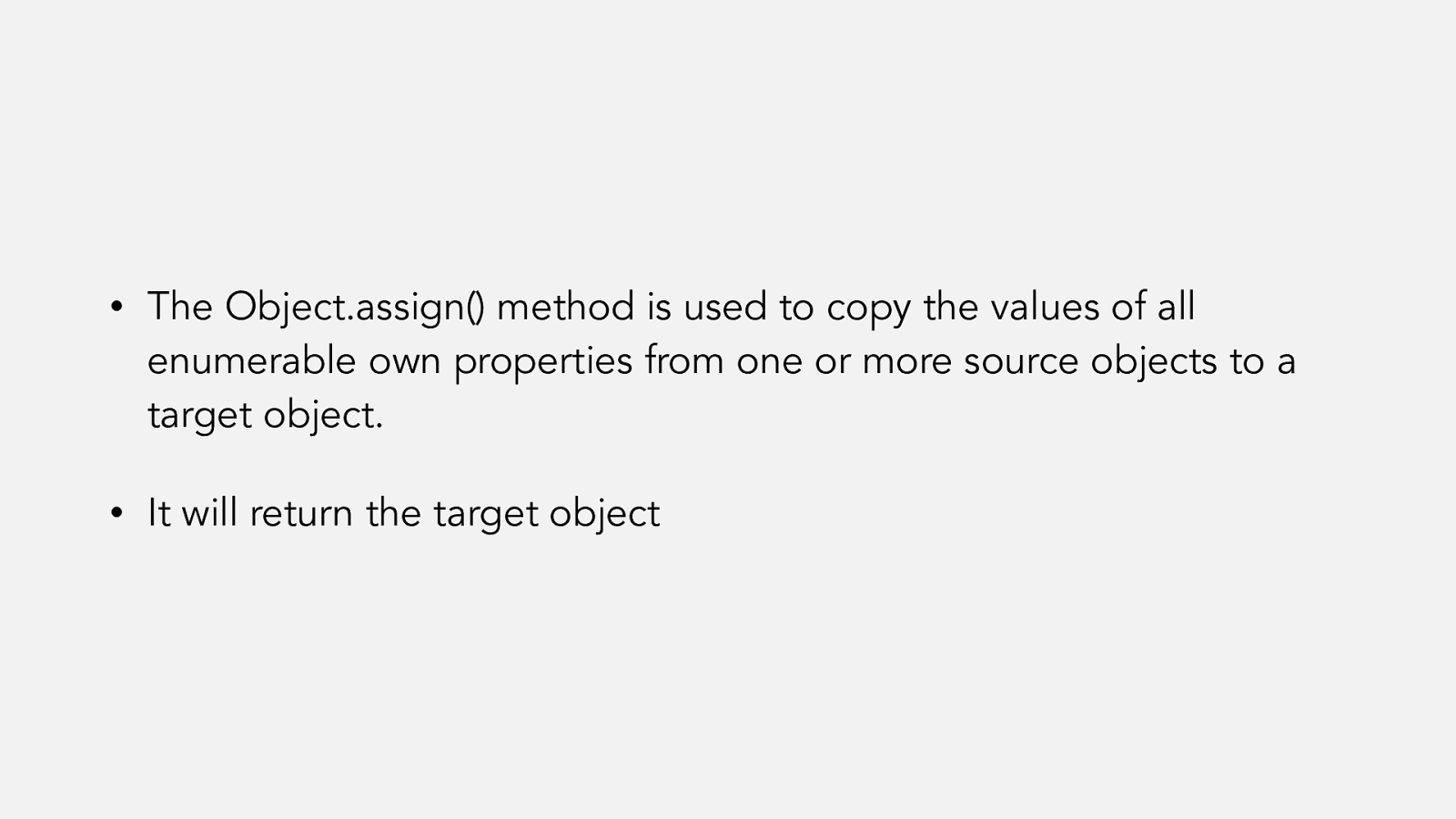
• The Object.assign() method is used to copy the values of all enumerable own properties from one or more source objects to a target object.
• It will return the target object
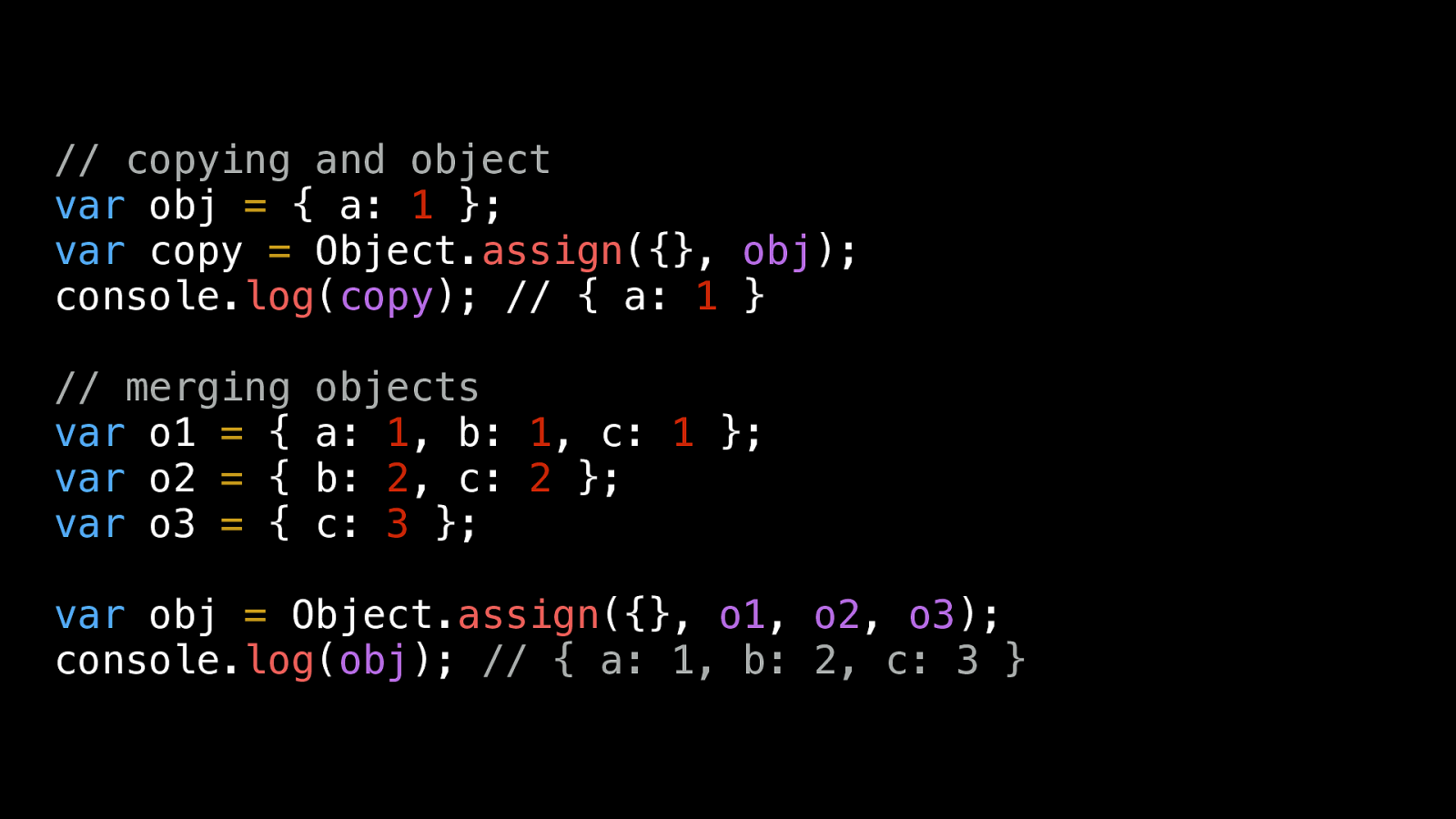
Object. assign ({}, obj ); console. log ( copy ); // { a: 1 }
Object. assign ({}, o1 , o2 , o3 ); console. log ( obj ); // { a: 1, b: 2, c: 3 }

function test() {
'use strict' ;
{ b: {c: 4 } , d: { e: {f: 1 } } };
Object. assign ({}, a);
JSON. parse (JSON. stringify (a));
console. log (JSON. stringify (g.d)); // { e: { f: 1 } }
32 ; console. log ( 'g.d.e set to 32.' ); // g.d.e set to 32.
console. log (JSON. stringify (g)); // { b: { c: 4 }, d: { e: 32 } }
console. log (JSON. stringify (a)); // { b: { c: 4 }, d: { e: 32 } }
console. log (JSON. stringify (h)); // { b: { c: 4 }, d: { e: { f: 1 } } }
54 ; console. log ( 'h.d.e set to 54.' ); // h.d.e set to 54.
console. log (JSON. stringify (g)); // { b: { c: 4 }, d: { e: 32 } }
console. log (JSON. stringify (a)); // { b: { c: 4 }, d: { e: 32 } }
console. log (JSON. stringify (h)); // { b: { c: 4 }, d: { e: 54 } }
} test ();
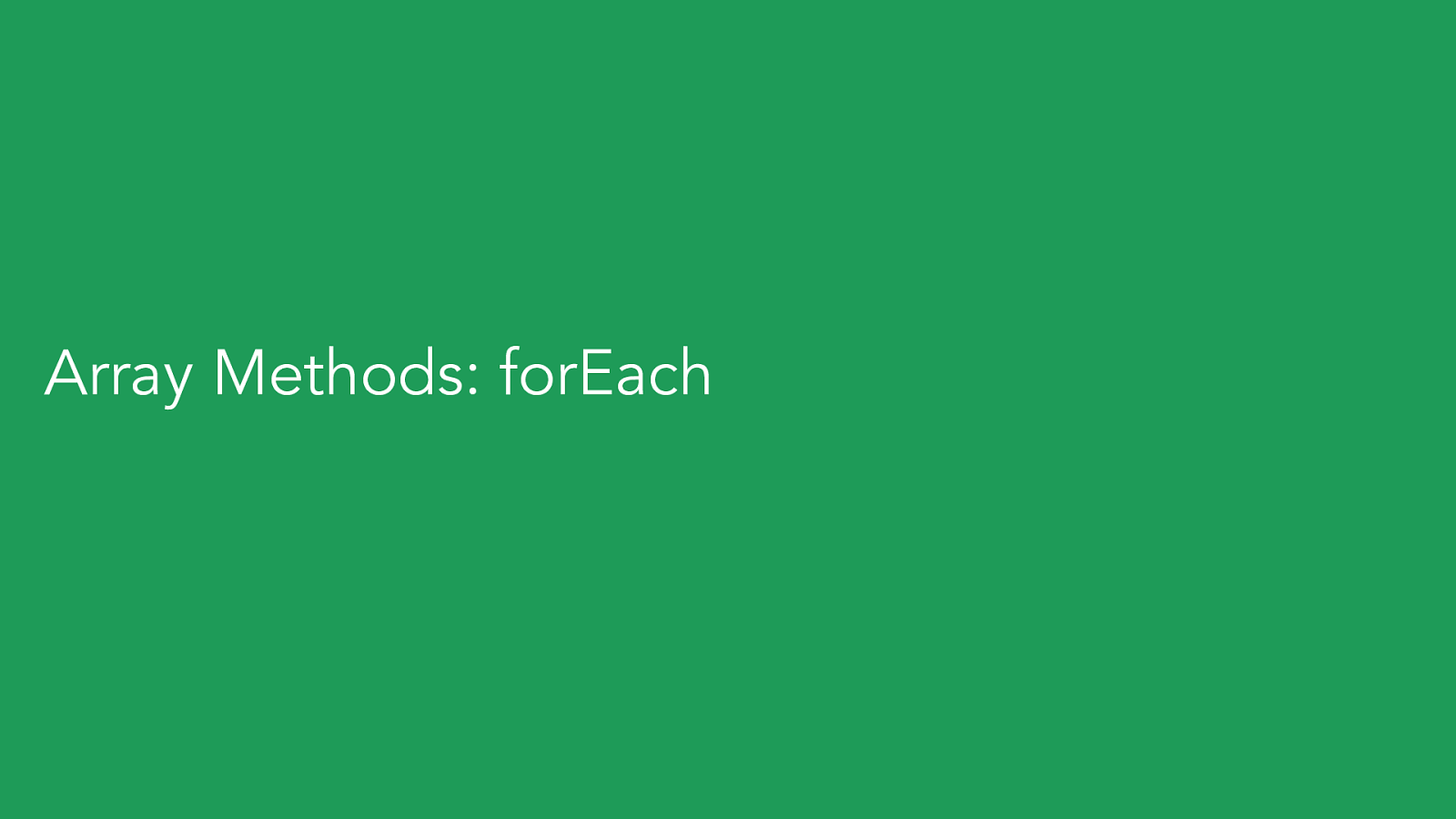
Array Methods: forEach

• The forEach() method executes a provided function once for each
array element.
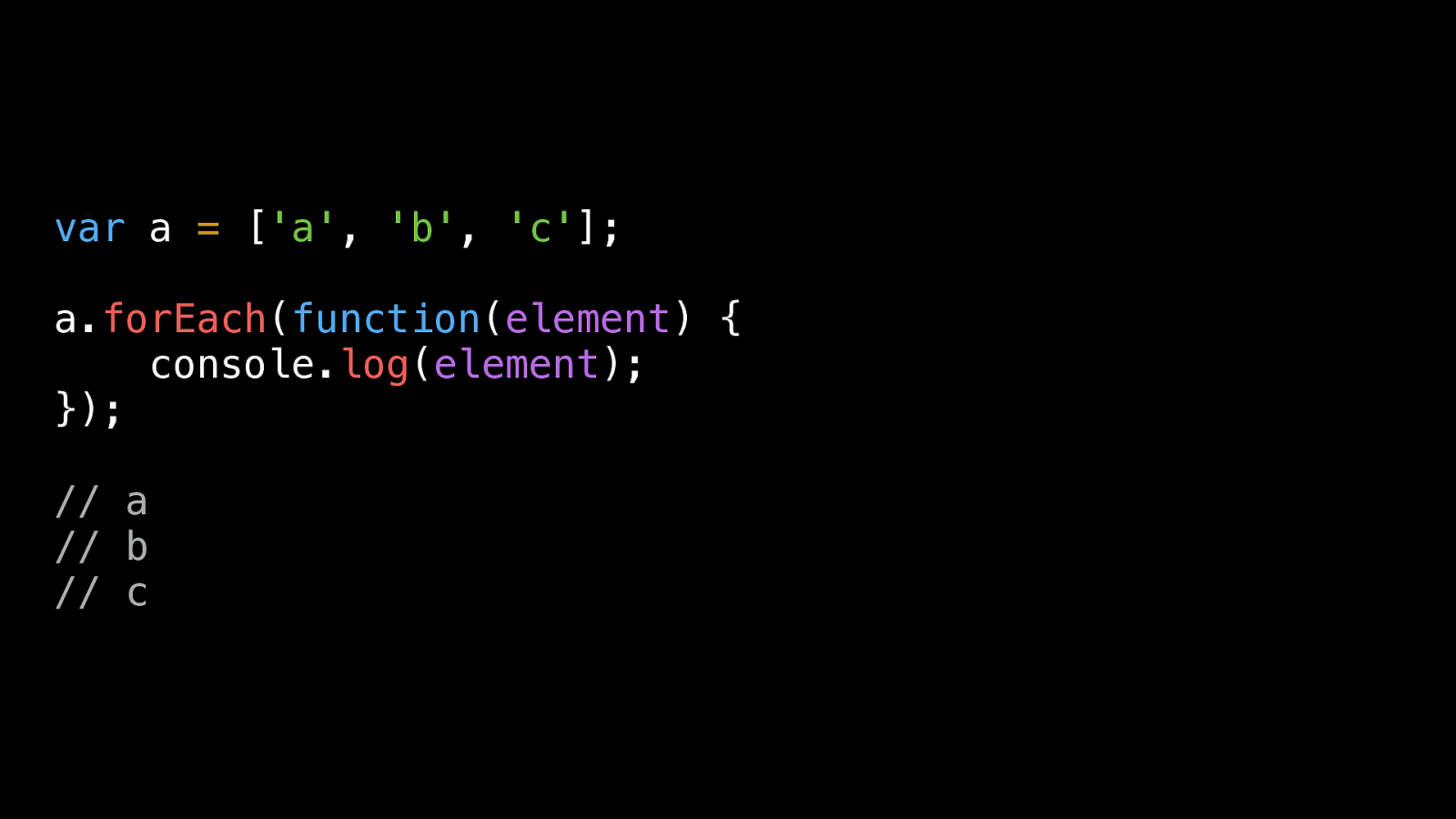
[ 'a' , 'b' , 'c' ]; a. forEach ( function ( element ) { console. log ( element ); }); // a // b // c

Array Methods: map

• The map() method creates a new array with the results of calling a provided function on every element in this array.

numbers. map ( function ( x ) {
numbers. map (Math.sqrt); // roots is now [1, 2, 3] // numbers is still [1, 4, 9]

Array Methods: filter
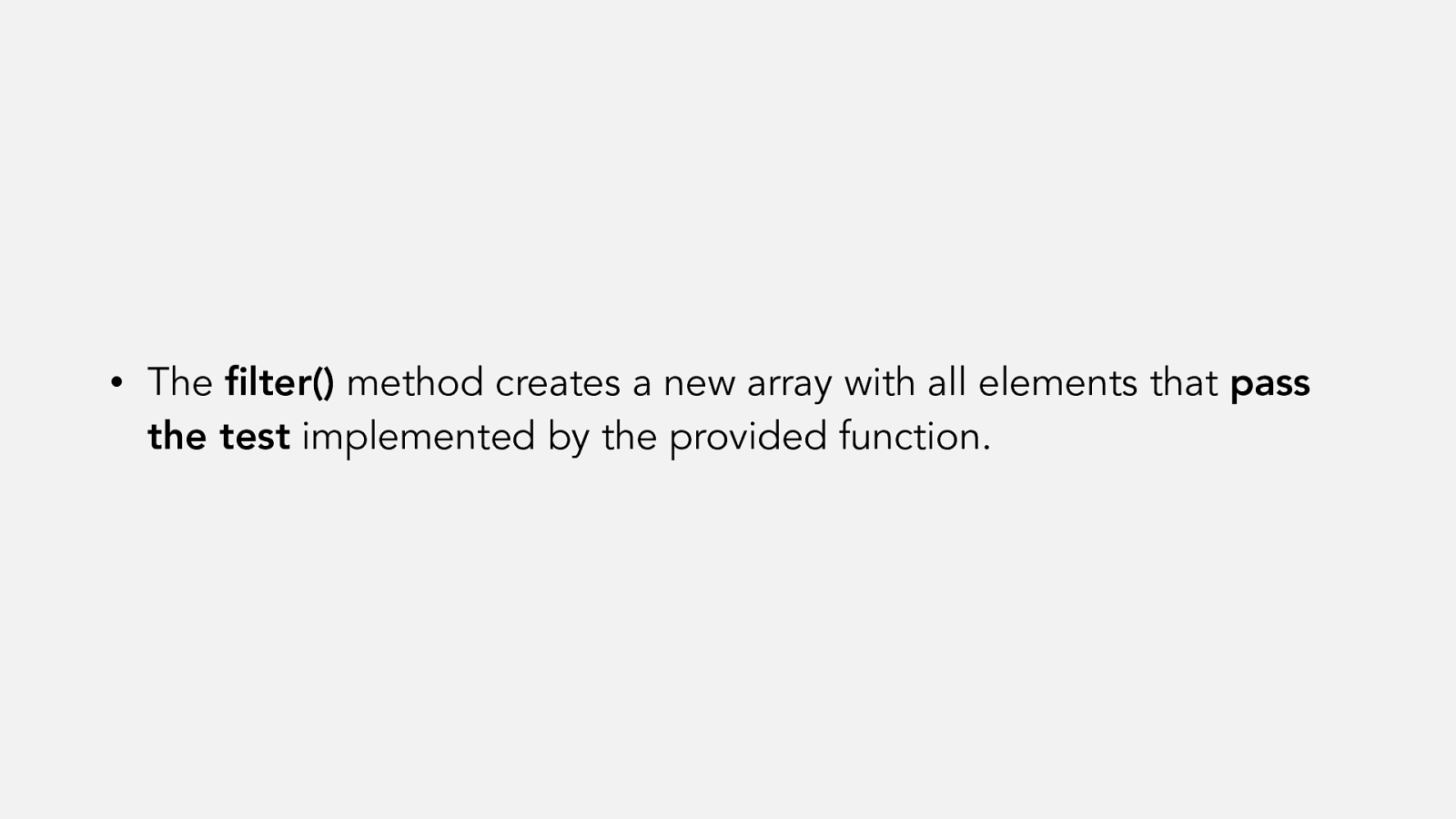
• The filter() method creates a new array with all elements that pass the test implemented by the provided function.
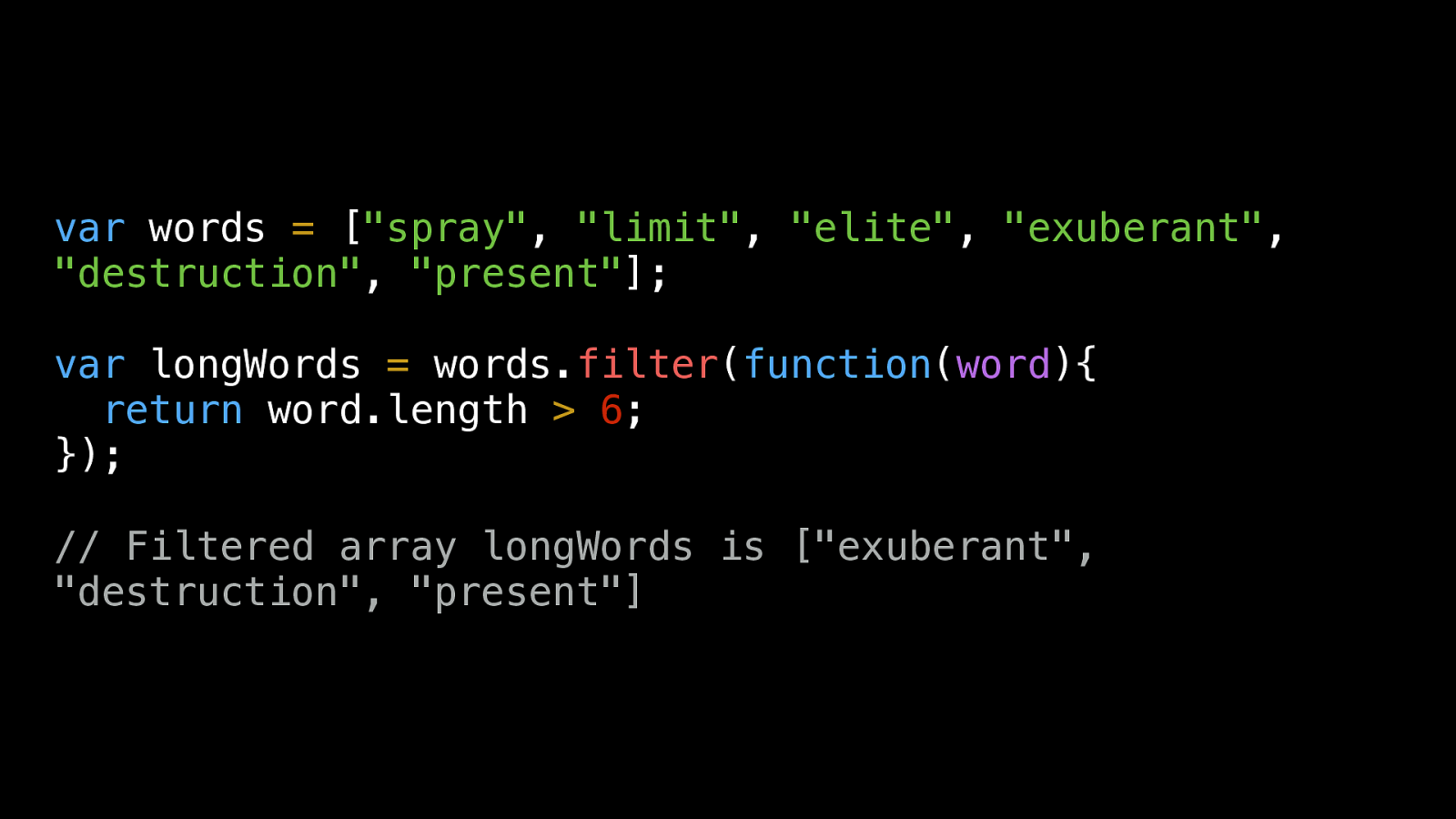
words. filter ( function ( word ){
return word.length
6 ; });
// Filtered array longWords is ["exuberant", "destruction", "present"]
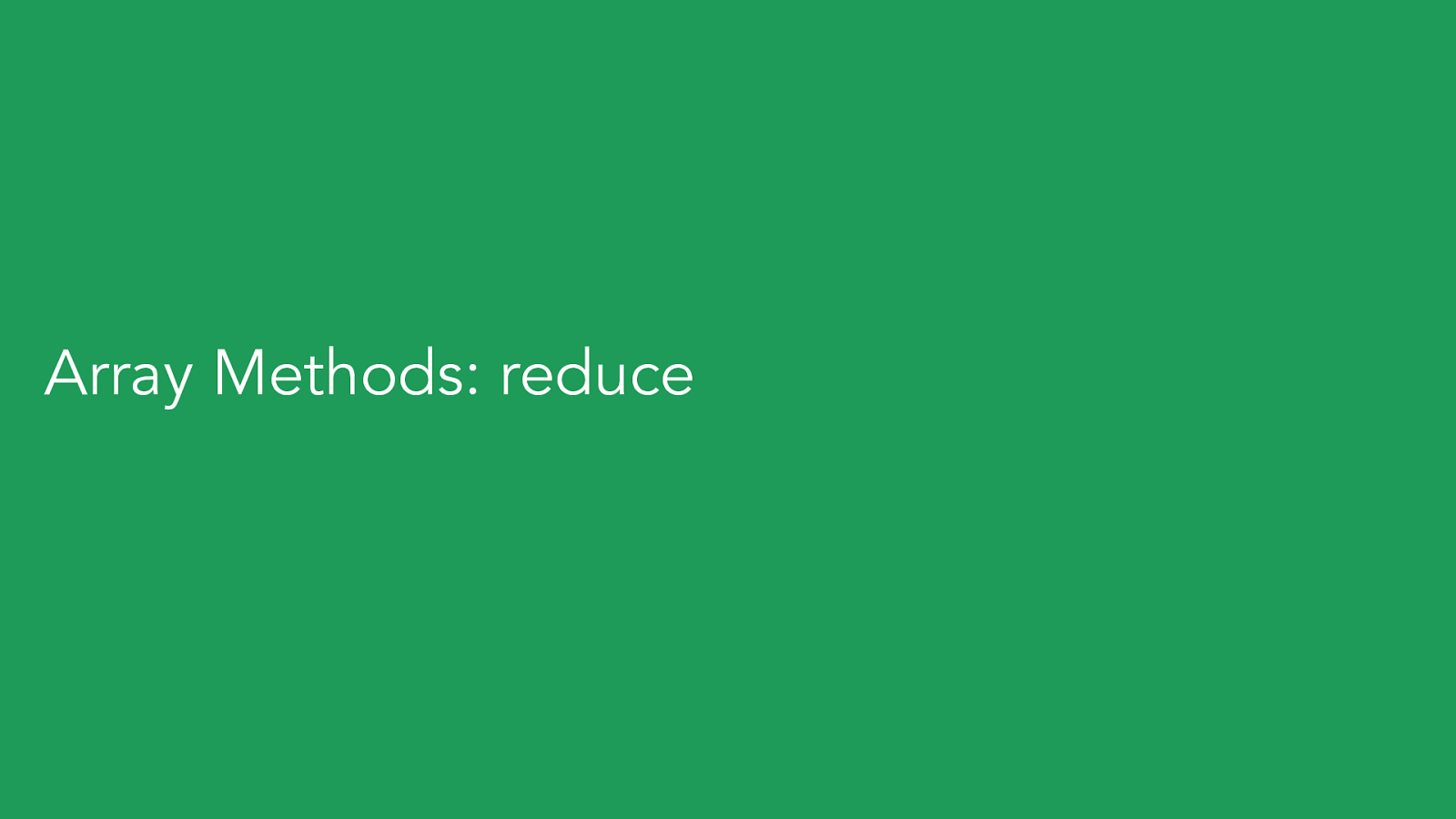
Array Methods: reduce
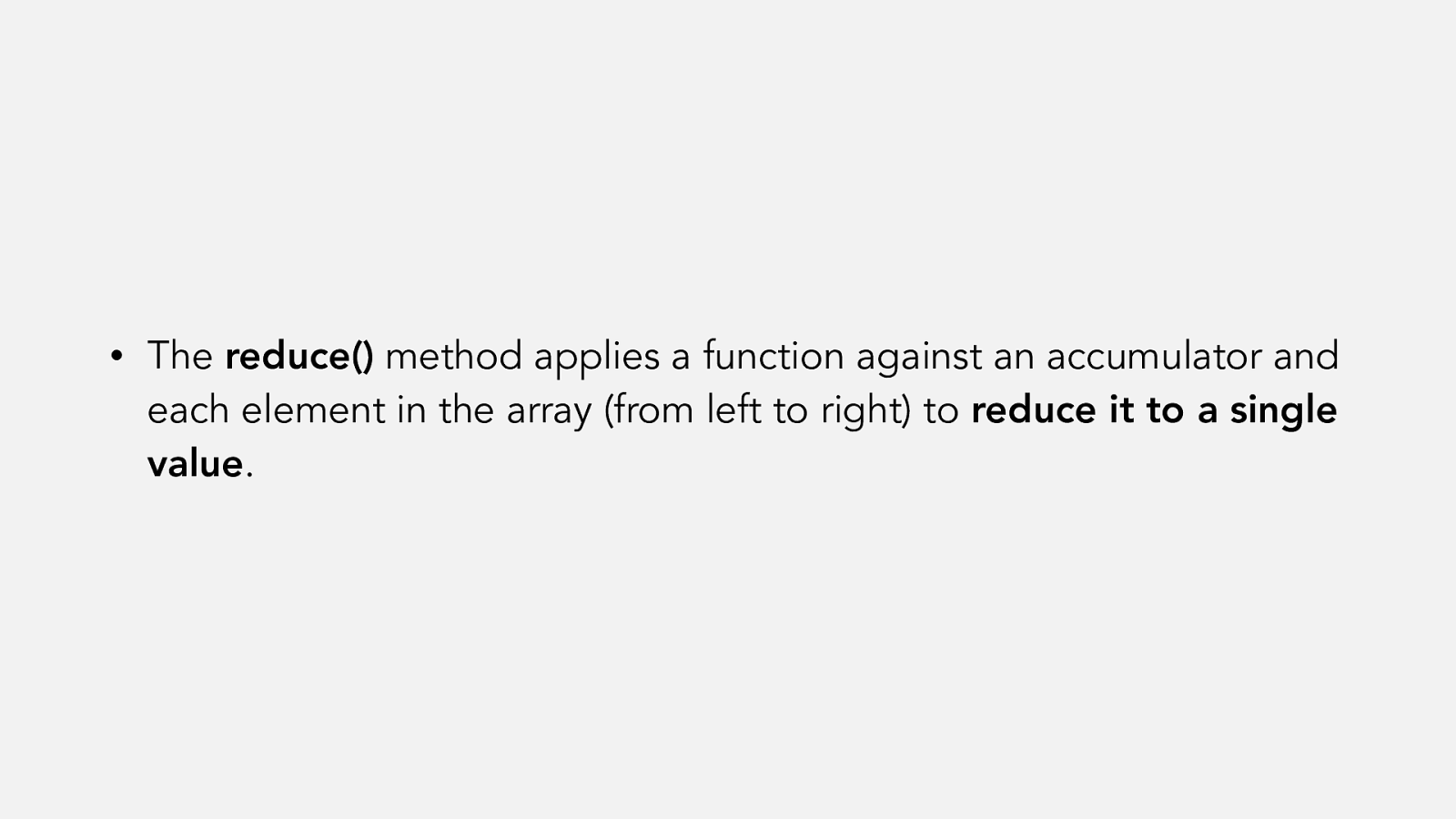
• The reduce() method applies a function against an accumulator and each element in the array (from left to right) to reduce it to a single value .
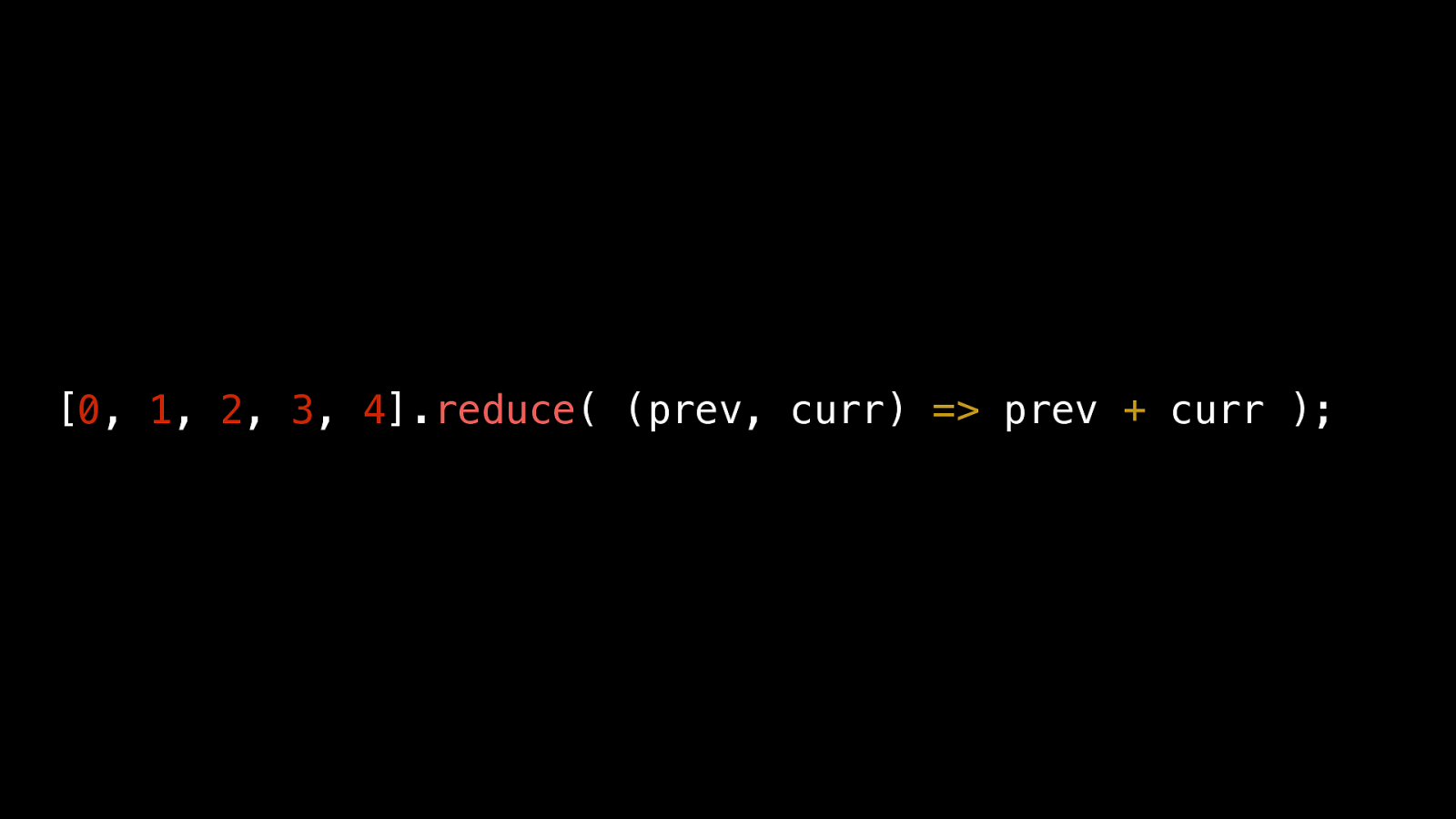
[ 0 , 1 , 2 , 3 , 4 ]. reduce ( (prev, curr) => prev + curr );
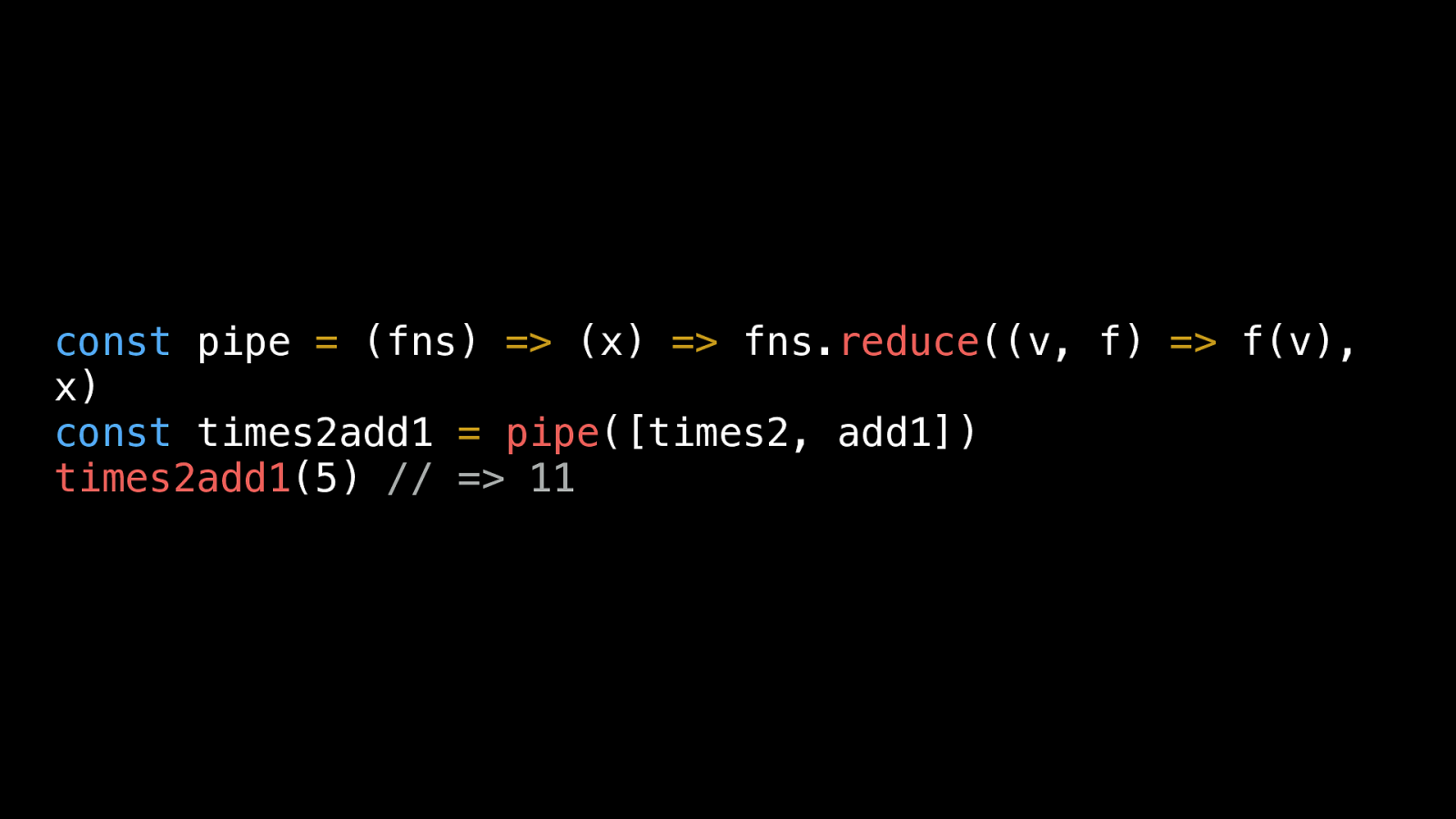
pipe ([times2, add1]) times2add1 (5) // => 11

Import/Export
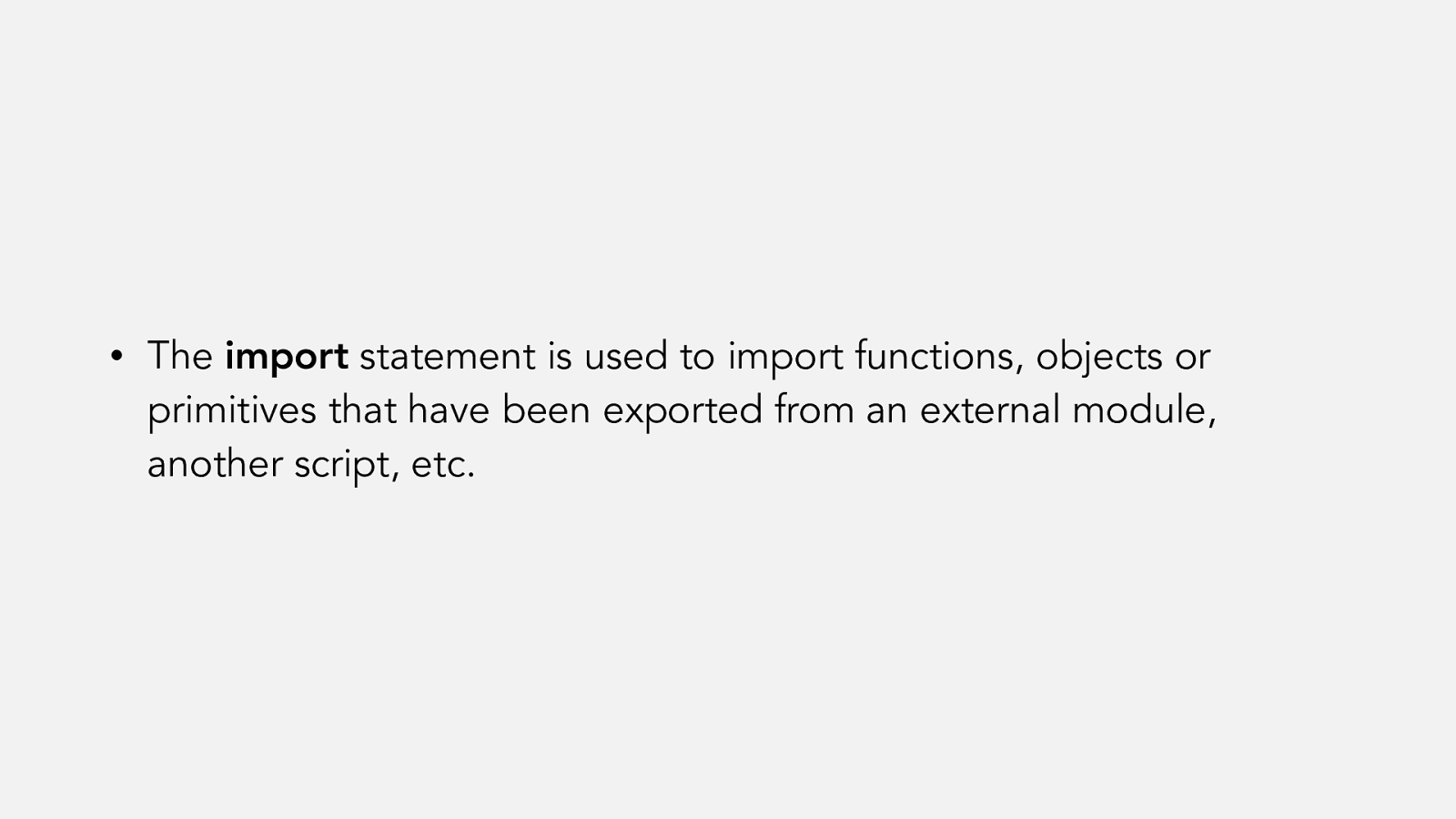
• The import statement is used to import functions, objects or primitives that have been exported from an external module, another script, etc.
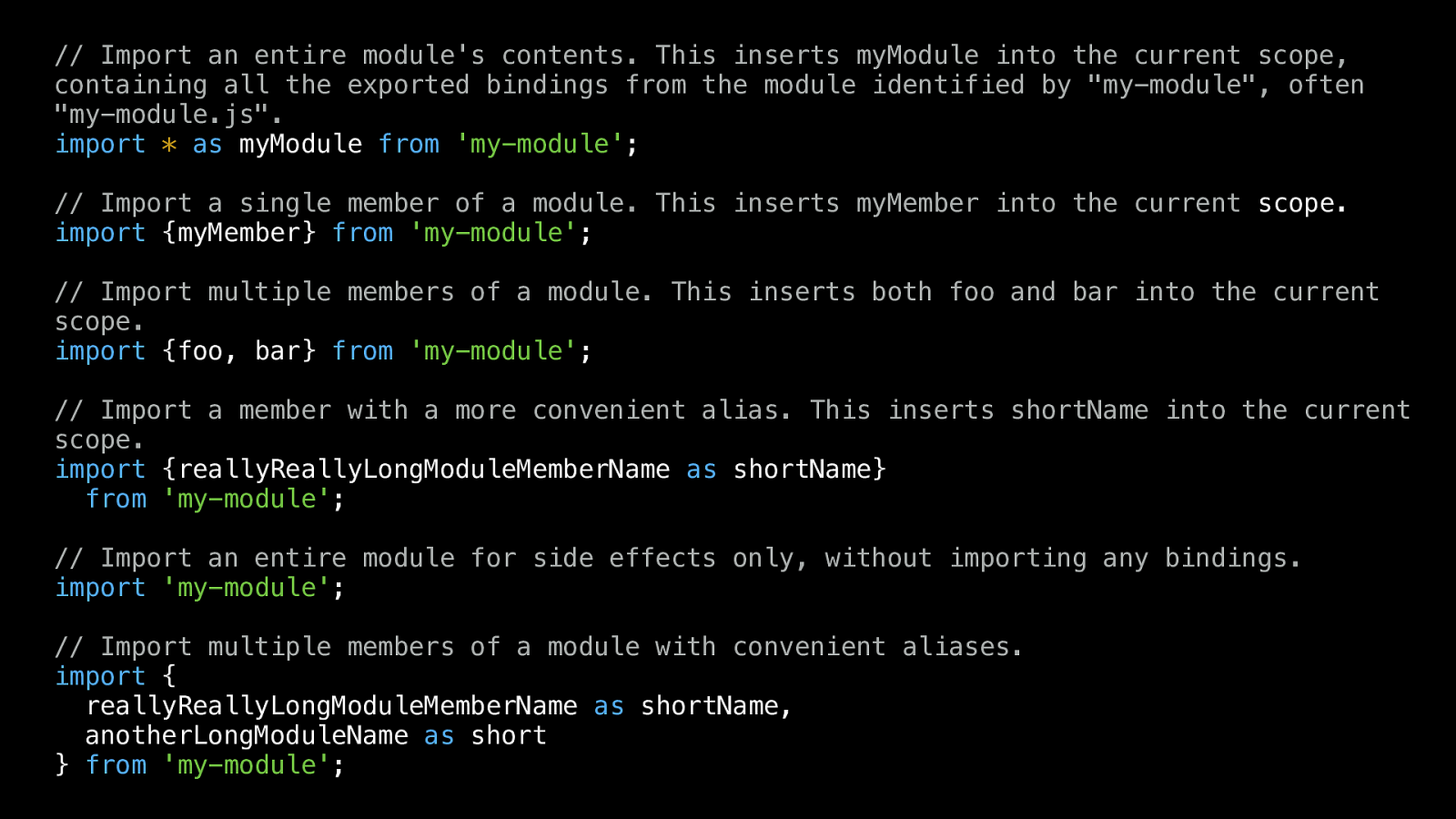
// Import an entire module's contents. This inserts myModule into the current scope, containing all the exported bindings from the module identified by "my-module", often "my-module.js".
import
as myModule from
'my-module' ; // Import a single member of a module. This inserts myMember into the current scope. import {myMember} from
'my-module' ; // Import multiple members of a module. This inserts both foo and bar into the current scope. import {foo, bar} from
'my-module' ; // Import a member with a more convenient alias. This inserts shortName into the current scope. import {reallyReallyLongModuleMemberName as shortName}
from
'my-module' ; // Import an entire module for side effects only, without importing any bindings. import
'my-module' ; // Import multiple members of a module with convenient aliases. import { reallyReallyLongModuleMemberName as shortName, anotherLongModuleName as short } from
'my-module' ;
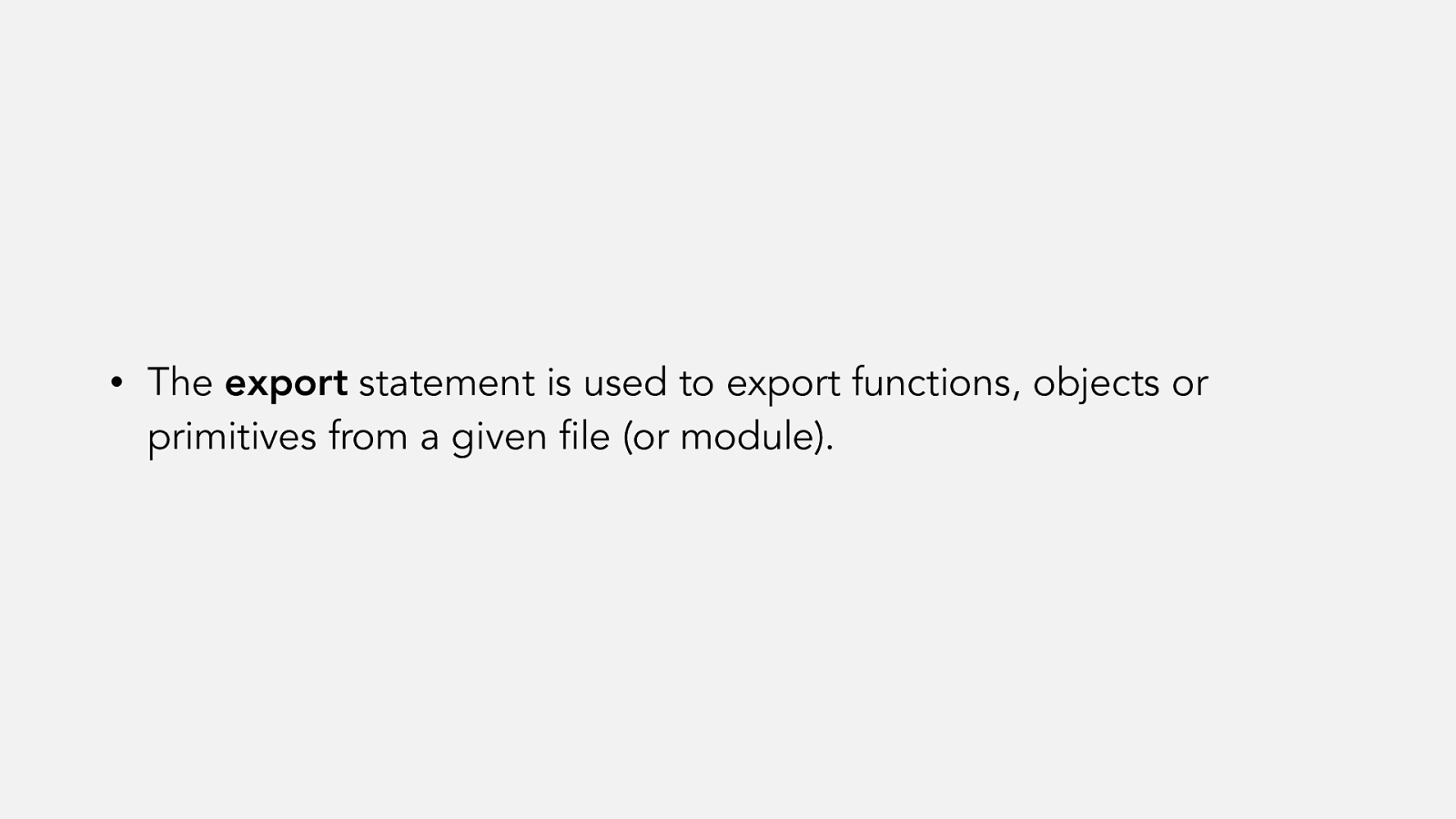
• The export statement is used to export functions, objects or primitives from a given file (or module).
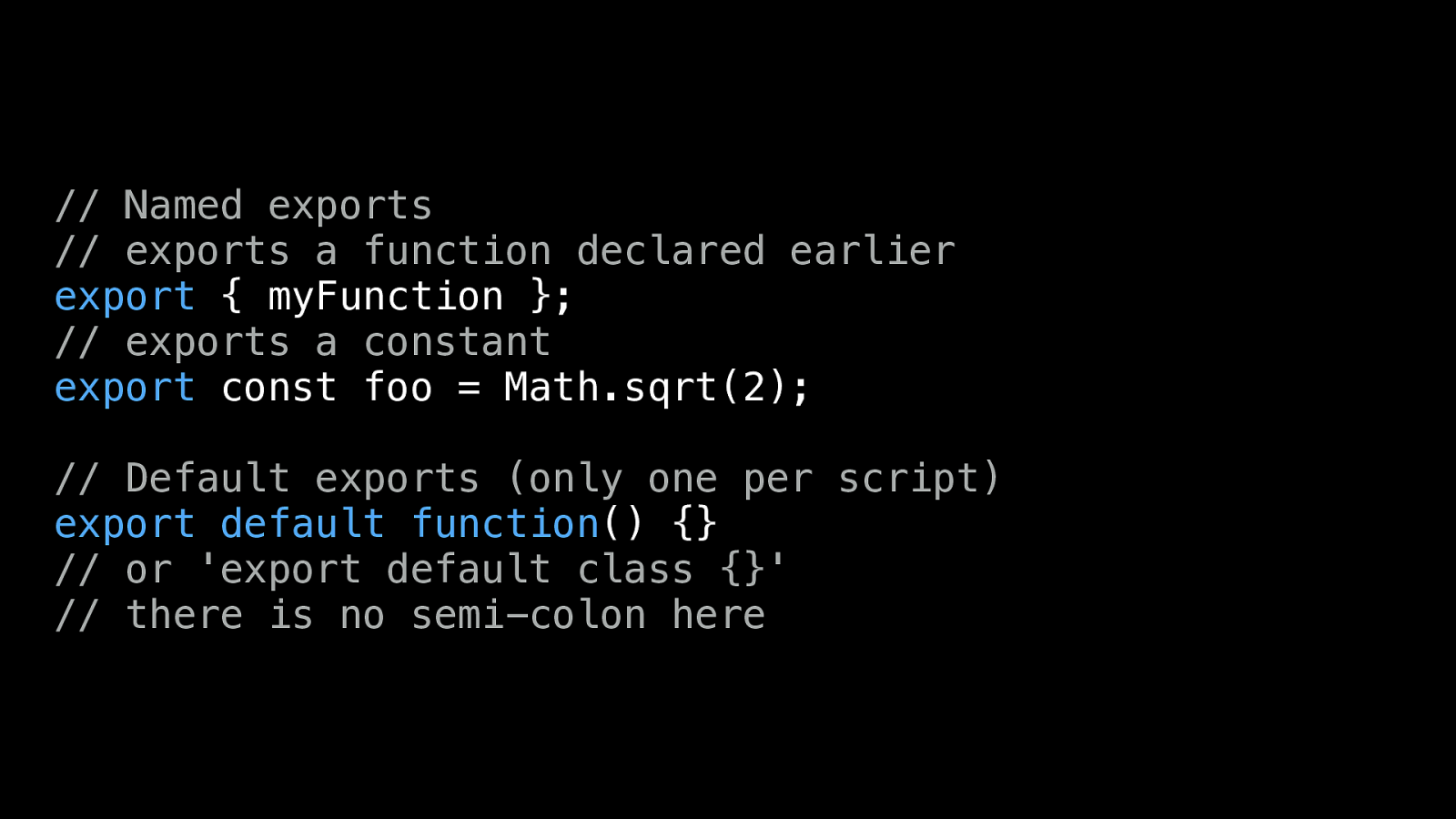
// Named exports // exports a function declared earlier
export { myFunction };
// exports a constant export const foo = Math.sqrt(2); // Default exports (only one per script) export default function () {}
// or 'export default class {}' // there is no semi-colon here

Classes
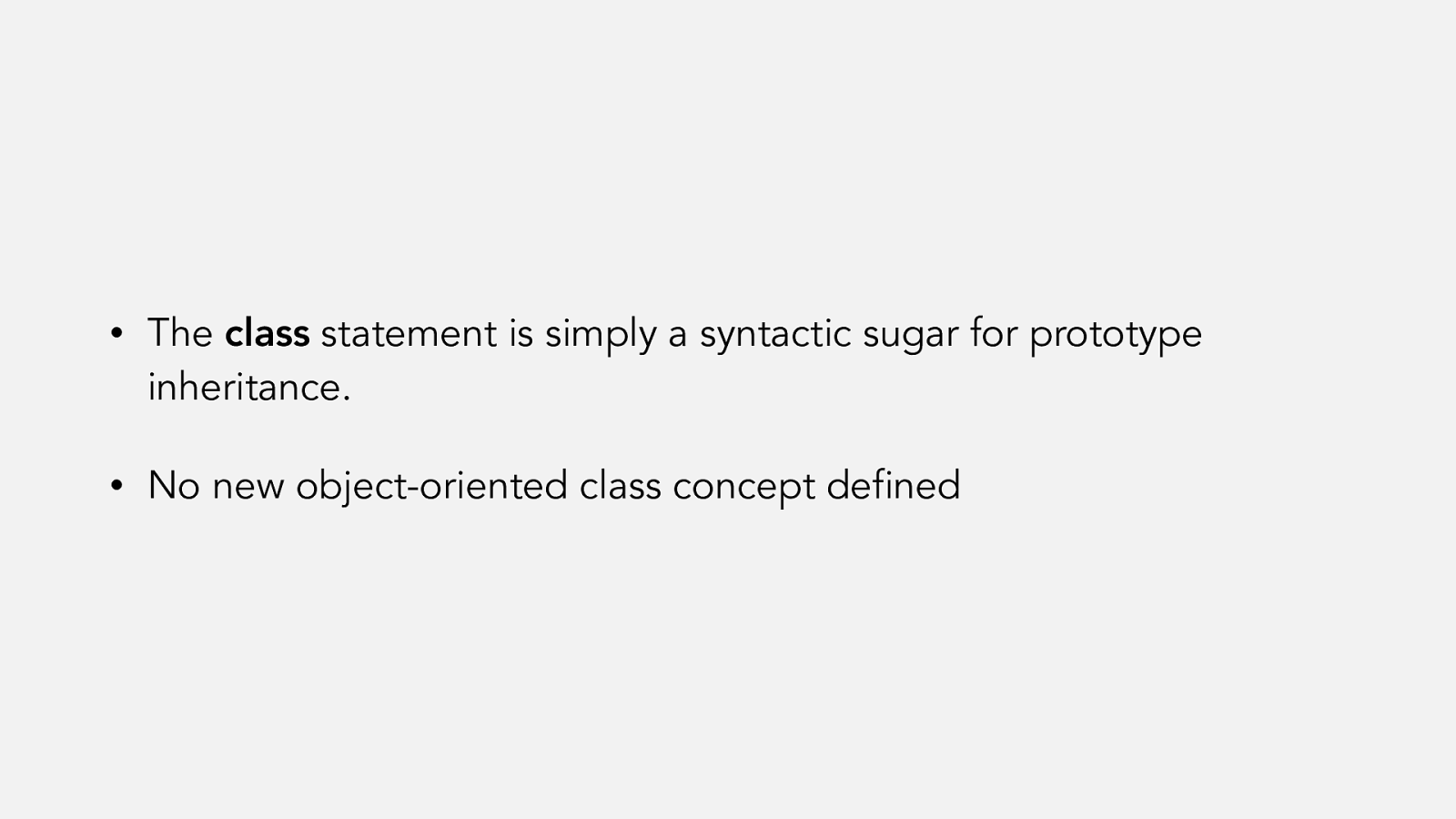
• The class statement is simply a syntactic sugar for prototype inheritance.
• No new object-oriented class concept defined
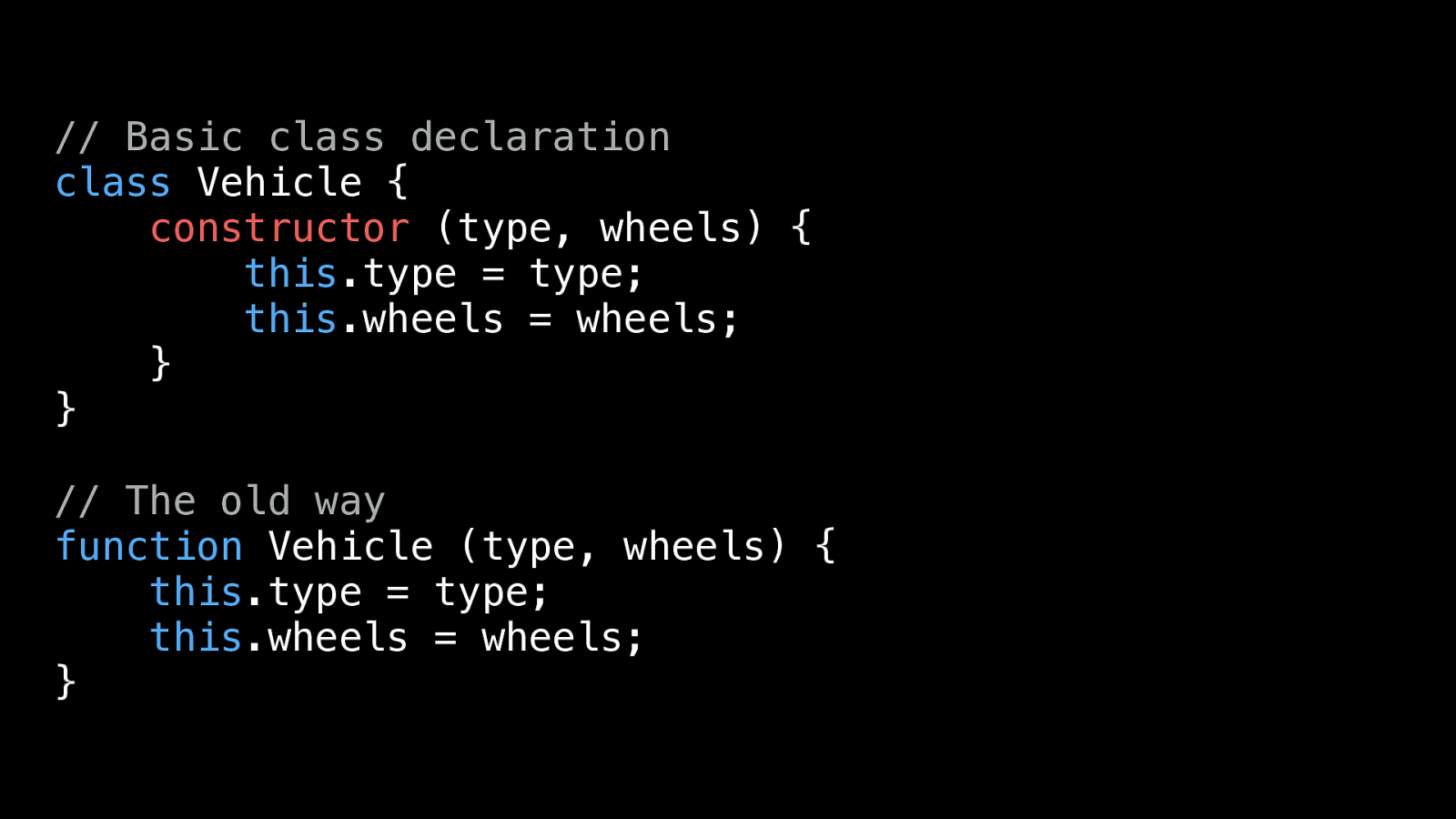
// Basic class declaration
class
Vehicle {
constructor (type, wheels) {
this .type = type;
this .wheels = wheels; } } // The old way function
Vehicle (type, wheels) {
this .type = type;
this .wheels = wheels; }
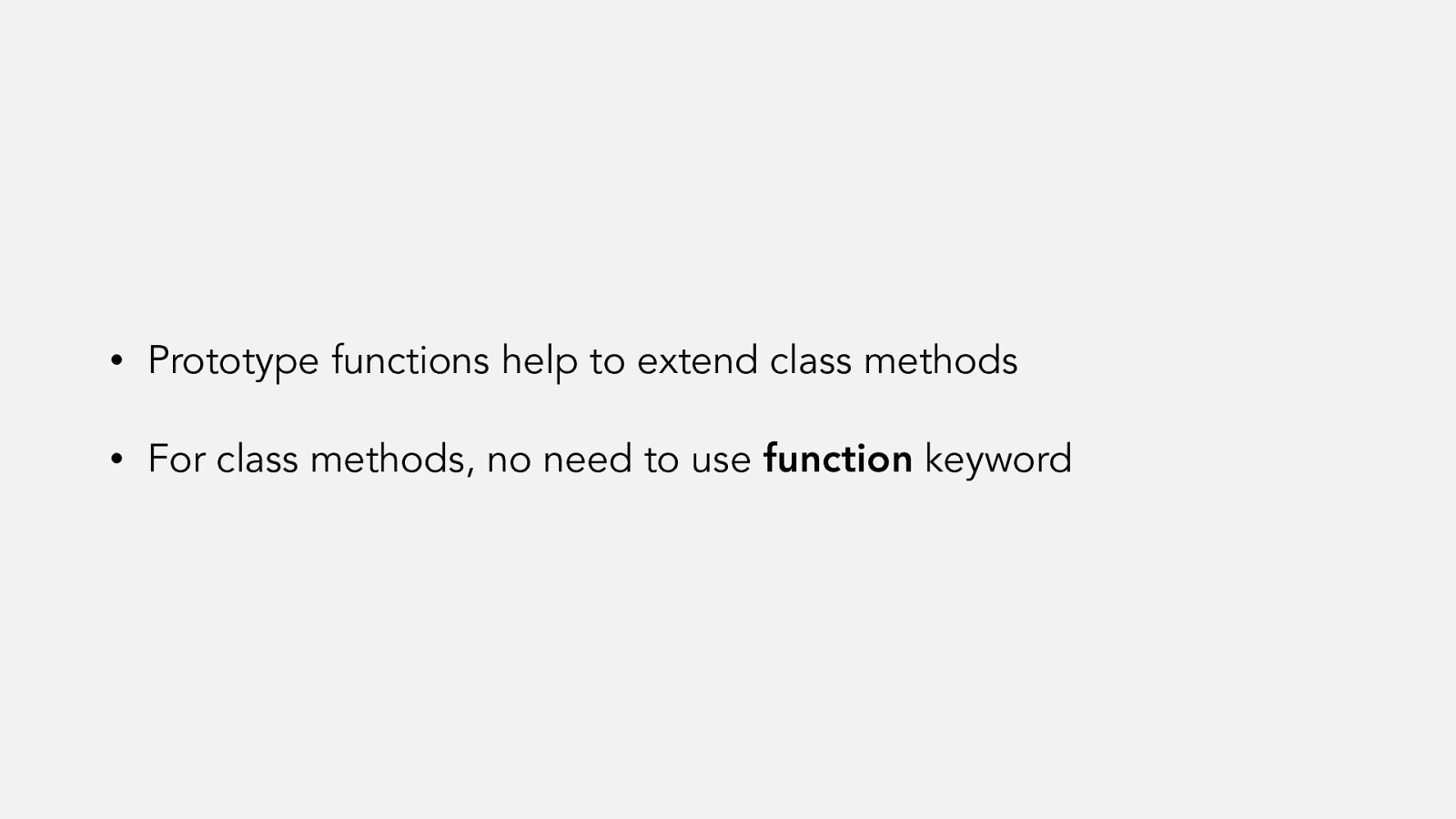
• Prototype functions help to extend class methods • For class methods, no need to use function keyword
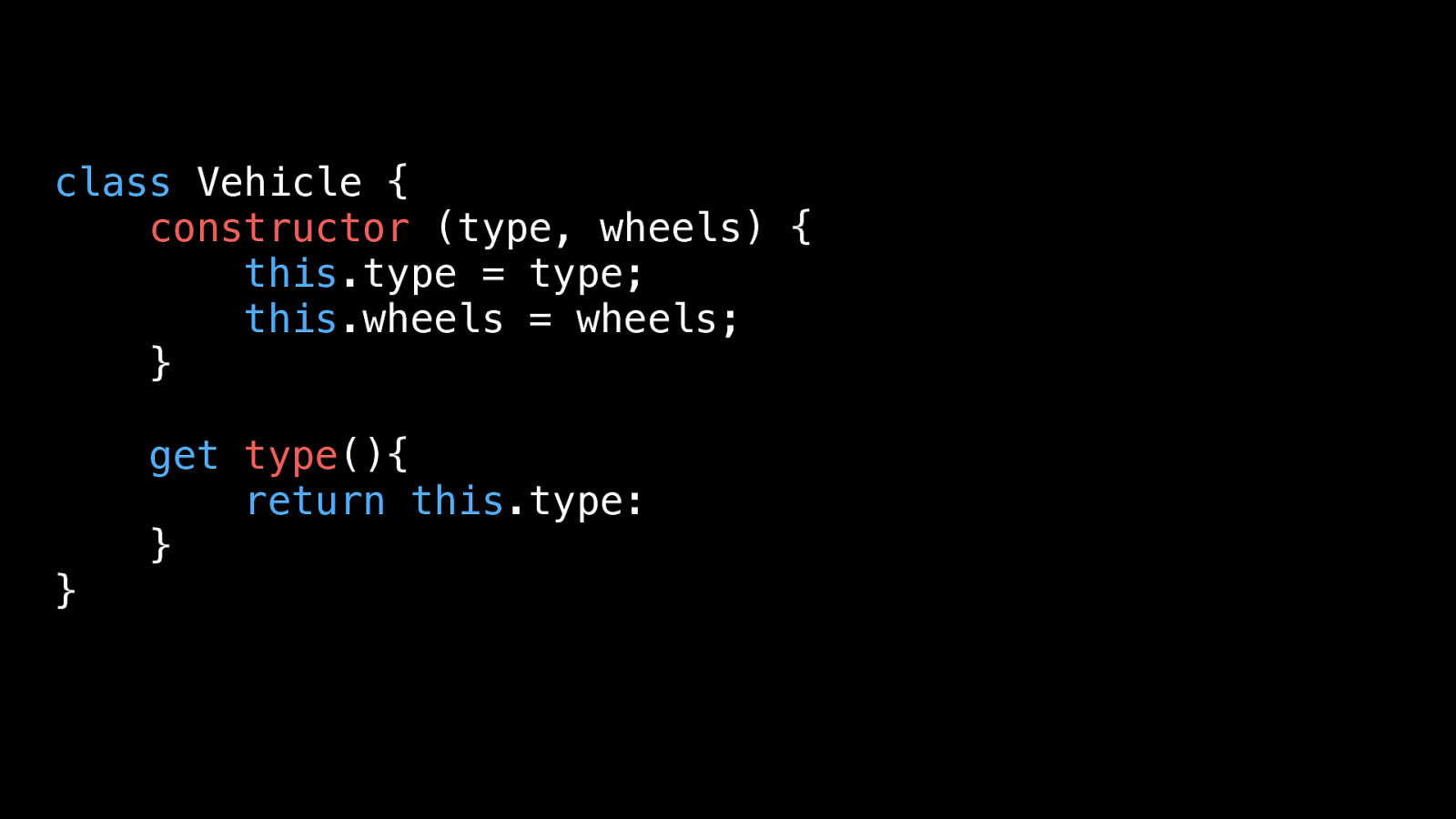
class
Vehicle {
constructor (type, wheels) {
this .type = type;
this .wheels = wheels; }
get
type (){
return
this .type: } }

Promises
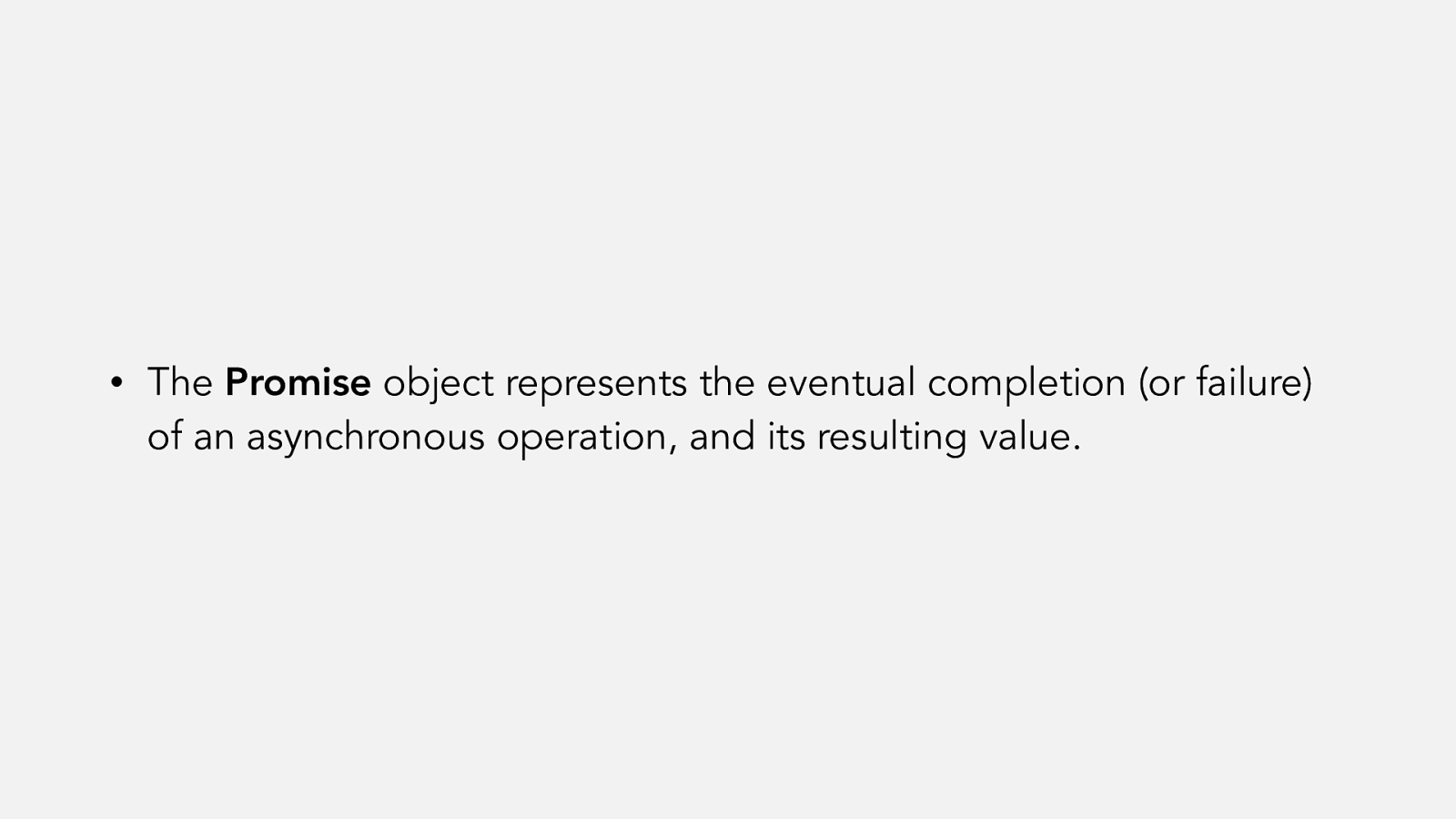
• The Promise object represents the eventual completion (or failure) of an asynchronous operation, and its resulting value.
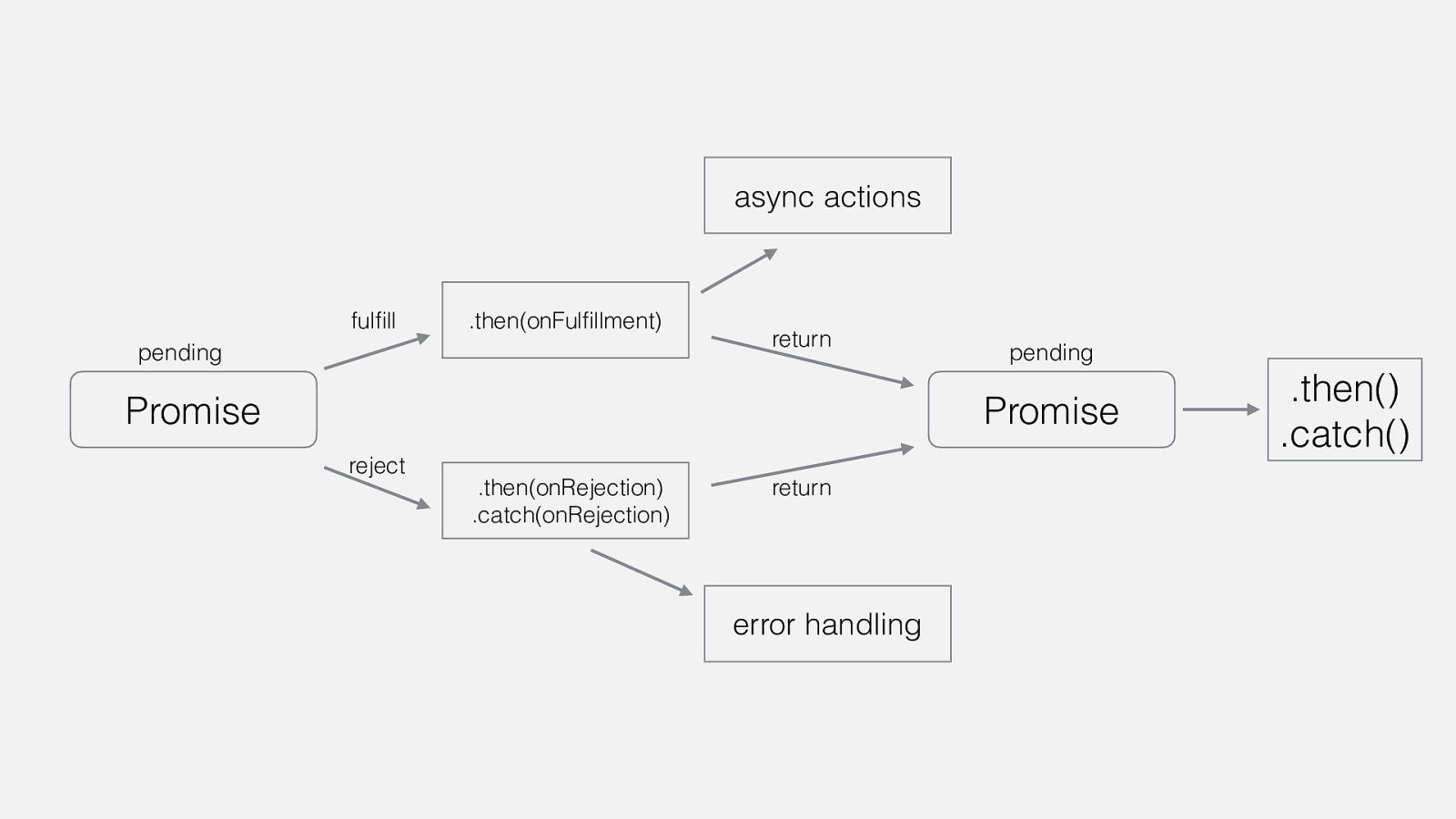
.then() .catch() Promise pending fulfill reject return return pending Promise error handling .then(onRejection) .catch(onRejection) .then(onFulfillment) async actions